Archaeologists and numismatic scholars are coming to an agreement that the coins were invented independently at three different locations on the eurasian continent between 700-600 BCE. They are Lydia, India and China, shown in the map below. Evidence exists for Lydian coins but only circumstantial evidence exist for the Indian and Chinese coins of this period.
|
South western part of present day Turkey was known in antiquity as Lydia. Ionians (greek settlers on the east coast of Asia minor) described their eastern neighbors Lydians as the people with dark hair and olive colored skin. There was a vigorous trade between the Ionian city states and Lydian kingdom. Lydian rulers and Ionian city state rulers were also related by marriage. Many historians and archaeologists speculate that increased trade was a spark for invention of the coins. Coins might had facilitated a move from cumbersome barter system of trade to simple system based on the money. Others speculate that they were stuck as offerings to the Gods in their religious ceremonies. Lydian coins found in Ionian mainland temple of Greek goddess Artemis (Romans called her Diana) during archeological excavation in 1951 gives credence to such speculation. Logically, both ideas make sense but we may never know.
Writings of Herodotus (greek historian) also tell us that Lydian king Croesus had given great number of coins to the temple at Delphi. Croesus asked advice from the Oracle as to the success of his invasion of Persian kingdom. The Oracle told him that if he crossed the river he would destroy a great kingdom. Encouraged, he proceeded with the invasion. Ironically, Persian King Cyrus the Great won the war in 546 BCE and destroyed Lydian kingdom. Persian King acquired the Lydian mints and technology of making quality coins. Persians added copper to gold to prevent easy wear and tear of soft pure gold coins. Thus coin minting spread to Persia.
Between 600-575 BCE, mainland greek city states learned technology of coin making and started producing their own coins. Silver coins started appearing in Aegina (595-456 BCE), Athens (575 BCE), Corinth (570 BCE). Thus coins spread to the western part of the eurasian continent.
Herodotus mentions in his writing about crude Lydian coins in the year 687 BCE. First coins of Lydia were lumps of electrum (naturally occurring amalgam of silver & gold). Electurm lumps were found in mountain streams of Lydia. They were heated to soften, placed on a plate and struck with a punch and hammer. This formed an incuse on one side and marked them as coins. These coins were produced at a mint constructed by Lydian king Ardys (652-15 BCE) in the capital city of Sardis. They were not true coins by present day definition because they were not of any standard weight & purity of metal or size.


1/3 Stater coin of Lydia
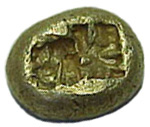
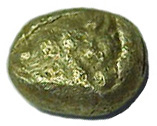
1 Stater coin of electrum of Lydia at the time of King Ardys (652-15 BCE)
Smaller coin has one square incuse and larger coin has two square incuses on obverse and rough surface on reverse.
Later king of Lydia, Alyattes (610-561 BCE), son of Ardys set a weight standard for the coin (168 grains of wheat for Stater- see picture below).
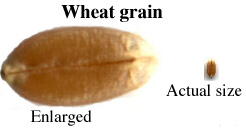
Advancements in metallurgy at this time created coins using anvil die to make a design on the reverse of the coin. Lion''s head was the symbol of Mermnad dynasty. Standard weight met the second condition to be a true coin.
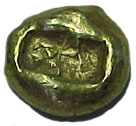
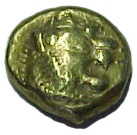
Stater of Lydia at the time of King Alyattes (610-561 BCE)
Two square incuses on obverse and head of a lion on reverse.
Credit of producing true coins in Lydia goes to King Coresus ( 561-46 BCE ) son of Alyattes. He set the standards for purity of metal (98 % gold or silver) and official seal of king on the obverse ( head a lion and Bull). This official seal guaranteed the value of the coin by the King. This met the third condition to be a true coin of the modern definition.
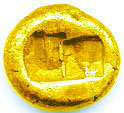
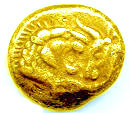
Gold stater of King Coresus ( 561-46 BCE )
Head a lion and bull on reverse and two square incuses on obverse.
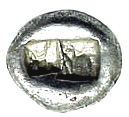
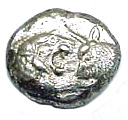
Silver Double Siglos coin of King Coresus ( 561-46 BCE ) .
Head a lion and bull on reverse and two square incuses on obverse.
Early coins of India
Around 600 B.C.E., India had many prosperous small kingdoms trading with each other and outside kingdoms. This period is referred in the literature of indian history as "Early kingdoms". During this time, quality and weight of silver bullion was standardized to reduce the inconvenience of weighing the silver bullion for every transaction. As mentioned earlier, there is only circumstantial evidence for independent invention of coins in India. It comes from the writers of indian literature during 5th and 4th century BCE and standardization of weight measurements for coins based on different system.
Panini, Sanskrit grammarian ( c500 BCE) in his treatise Astdhyayi wrote about coins and various fractions suggesting that the concept of coins existed prior to 500 BCE. He mentioned Satamanas (sata= 100, manas = units) and Karshapana ( subfraction). Each unit was called "Ratti" weighing 0.11 grams. Ratti was average weight of a Gunja seed (a bright red seed with a black tip - see the picture below).
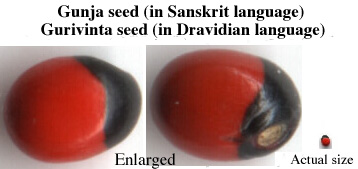
Satamana equals to 100 Rattis or 11 grams of pure silver. One Karshapana equals to 32 Rattis or 3.3 grams of pure silver. Half Karshapana equals to 16 Rattis, 1/4 Karshapana equals to 8 Rattis and 1/8 Karshapana equals to 4 Rattis. The coins struck in India were different from those used in Lydia, Greece or Persia and it suggests an independent invention. Indian coins were cut out of a sheet of silver and clipped to adjust them into proper weight. These coins were always made of pure silver not gold or electrum. Square, rectangular and round shapes were used to make these coins. These early coins were then impressed on one side with one to six punch marks of sun with six radiating arms. The later coins were impressed with designs on both sides. These punch marks were probably guarantee for the purity and weight of the coin by the king of local kingdom. Most of the Kings of Early Kingdoms believed in the legends that they were the descendants of Surya (Sun) dynasty ( similar to Alexander's or Roman belief that they were descendants of Greeks heroes and Gods). The uniqueness of indian coins of early kingdoms, some archeological evidence and mention of the concept of coins in the early vedic literature points to an independent invention of coins in India. But the question is not fully resolved. See "Why a Rupee is called a Rupee?" for detailed discussion about the Indian coins.


1/8 Karshapana
circa 500 BCE
Punch mark of sun with six radiating arms on reverse
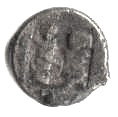
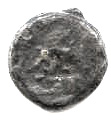
1/4 Karshapana
circa 300 BCE


1/2 Karshapana
circa 300 BCE
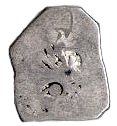
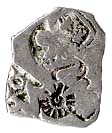
1 Karshapana
circa 500 BCE
several punch marks of sun with six radiating arms on reverse

Satamana (also known as bent bars)
circa 500 BCE.
Two punch marks of sun with six radiating arms on reverse on both ends of the silver bar.
Early coins of China
The shapes and manufacturing method of the coins can be considered as indirect evidence of independent invention in China. The chinese coins were made of base metals by casting . The earliest chinese coins were probably made in Yellow river valley. They were made of in the shape of miniature hoes, spades and knives. They were probably first issued around the 10th century BCE during the Zhou dynasty.
Several specimens of hollow handled spades with a pointed feet from Shantung peninsula were dated to be from 600 BCE. The dating of these coins is not considered definitive by many scholars. There is considerable disagreement among the numismatic scholars. Hollow handle spades with pointed feet are called Pu. They are considered to be the first coins by some. The name suggest that they might be transition money from primitive money. Pu was the term of earlier primitive money. These spades can not be considered as true coins for lack of stamping or inscriptions on them. However, they were cast to an ancient chinese weight standard of 1 liang = 24 shu (1 shu = 0.56g). These spades were cast to 3 liang.
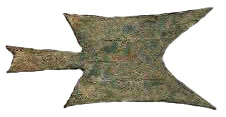
Hollow handled spade
Flat handled spades appeared around 400 BCE. They met all the conditions to be a true coin. They have inscriptions of denomination and mint marks. The flat spades were cast to an ancient chinese weight standard based on multiples of 12 shu (1 shu = 0.56g). They were issued in three denominations of 1/2 liang (12 shu), 1 liang (24 shu) and 2 liang (48 shu). They were called "CH'IEN. This word later come to mean money in Chinese language.

Flat handled spade
Thinner flat handled spade coins with a different weight standard appeared around 300 BCE. Their denominations were 1/2 liang (10 shu) and 1 liang (20 shu).
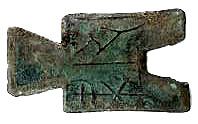
Thin flat handled spade
The knife money probably appeared around 500 BCE in the Yellow river valley. Some believe that they were cast earlier than 500 BCE. They were called "Ch'i" knifes. It is a difficult and contentious issue dating this Knife money. Pointed knives and Ming knives average between 15 and 16 grams or about 30 shu.

Ming Knife coin

Ming Knife coin
The round coins with round hole in the center appeared around 300 BCE. They have a mint mark and monetary units on them. They were cast with new weight standard. There came in two denomination 1/2 liang (10 shu or 5 grams) and 1 liang (20 shu or 10 g) and ch'ien.
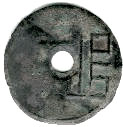
Round coins with round hole
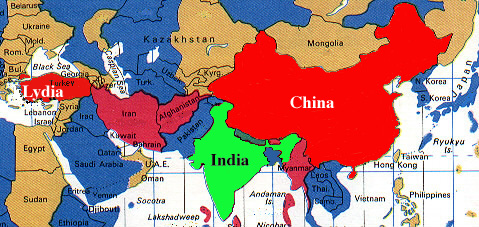
0 коментара:
Публикуване на коментар